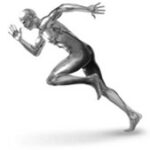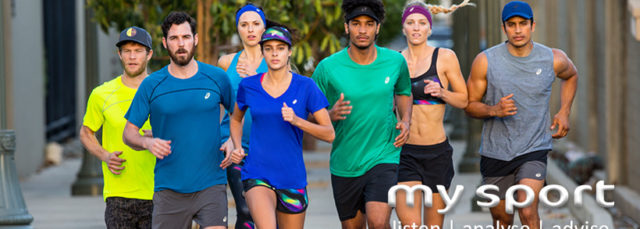What is an over-use injury? The majority of injuries affecting endurance sports are the result of repeated ‘submaximal’ loading. This is loading which isn’t large enough to tear a muscle or break a bone but leads to a gradual breakdown of tissue. These injuries generally progress from a mild niggle, which is often ignored, to pain which has a progressively greater impact on continued activity and pain at rest. It is also common that after a little discomfort the mild pain ‘warms up’ and exercise feels normal which only allows the injury to worsen.
Factors that influence the development of over-use injuries include biomechanical issues, technical issues and training errors, which I’ll go into more depth in below, and include some self-help tips.
Biomechanics
Biomechanics is concerned with how the body moves and what effects the movement of force through the body. An assessment of an individual’s biomechanics will reveal what is tight, what is weak, what is poorly controlled and what structural problems exist.
Typically biomechanics are not considered until something goes wrong but should always be looked at along with technical problems to get an understanding of what forces are being put on the body and how the body is able to deal with them.
The human body is very good at compensating and will find a way of managing as best it can to get a job done. It is when these coping mechanisms fail that excessive overload and injury develops.
When considering the forces applied to the body the important thing is the balance between mobility and control. The more mobility you have, the more movement you need to control.
Stiffness is also important to consider as the body, like everything, moves in the path of least resistance. If a structure is stiff it is able to resist a large amount of force before breaking but the force will move to the next easiest point. It is controlling the movement that is key to preventing injury.
Technique
Technique has a big influence on the size and direction of forces applied to the body.
Problems with technique reduce movement efficiency, increasing the effort you need to put in for the same result. This increases the amount of force that the body has to deal with leading to earlier fatigue and further loss of form.
With loss of efficiency, we can see an immediate effect on performance – a runner may lose form in a sprint finish, effort increases, speed decreases and they get caught on the line. Over time, persistent inefficient movement increases the risk or frequency of injury. Common technique problems that reduce efficiency include:
- Over striding
- Shuffling
- Bouncing
- Twisting/rotating
Training errors
Training error most commonly relates to an aggressive increase in quantity and/or intensity: Too much – too hard – too soon.
Over-loading the body is necessary to stimulate change but progression of training loads and intensity needs to be carefully controlled and increased over months and years as the body develops. As muscle strength increases the tendons, attachments to the bone and the underlying bone strengthen to be able to transfer force. If they are loaded too frequently, with too much intensity or for too long they can become fatigued, their ability to control and transfer load reduces and they can degenerate or inflame and become painful.
It’s worth noting that changing loads can involve changing the way force is applied, such as:
- Changes in running surface– the cambers of roads and footpaths or changing from road to trail, for example, involves changing angles of loading and the hardness or stability of the running surface.
- Ageing footwear– compression on part of the sole can lead to a change in the angle that the foot strikes the ground, changing the rate and amount of pronation through the foot and ankle.
- Changing techniquecan lead to the loading of weak tissue and adequate time is required to allow the development of appropriate strength.
How to reduce the risk of injury
To reduce the risk of injury we need to look at how much load is put on the body, how the body is able to manage this load and then control how the training loads are progressed. Following an individual biomechanical assessment, it is possible to address structural problems and develop an individual conditioning program for mobility, strength and endurance.
Assessment of your running action will highlight problems with movements that increase load and reduce efficiency. Sorting these problems will help to reduce the stress that can lead to injury and also increase speed.
Keeping a training diary allows you to look back over your training, how you progressed and what happened leading up to injury. This will give you a better understanding of your tolerance to training, will help to predict a safe rate of progression and where weaknesses leave you prone to injury. A program can then be designed which is challenging enough to force improvement while minimising the risk of injury.
Self-treatment & prevention tips:
When you first become aware of any little niggles try the following:
Ice massage
Massaging with an ice cube in the tender area can help to reduce any inflammation, but be sure to keep the ice moving to avoid ice burns.
Stretching
To reduce the tension in tight muscles but keep this comfortable, there shouldn’t be any pain and if you suspect a tear avoid this initially.
Self-massage
While typically less intense than a massage received in treatment, self-massage on a regular basis is a great method of reducing muscle tightness and in the case of muscular injury is more appropriate than stretching.
Rest
Rest is a relative term! It depends on severity. Reductions in training volume or intensity can be enough to allow mild symptoms to ease and if not, more severe restrictions in activity up to complete rest could be necessary, along with treatment. While easing off running, cross training can be used to prevent loss of strength and fitness.
The earlier you recognise a problem isn’t easing and seek assessment and treatment, the less likely you are to suffer prolonged pain or risk enforced rest from training.




